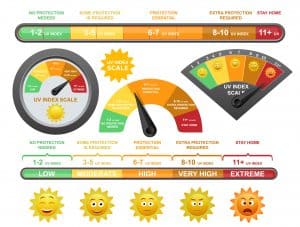Ultraviolet (UV) radiation and skin cancer
16 October 2017 | Q&A – World Health Organization
What are the different types of skin cancer?
 Non-melanoma skin cancers
Non-melanoma skin cancers
Non-melanoma skin cancers comprise basal cell carcinomas and squamous cell carcinomas. These are rarely lethal but surgical treatment is painful and often disfiguring. The temporal trends of the incidence of non-melanoma skin cancers are difficult to determine, because reliable registration of these cancers has not been achieved. However, specific studies carried out in Australia, Canada and the United States, indicate that between the 1960s and the 1980s the prevalence of non-melanoma skin cancers increased by a factor of more than two.
The risk of non-melanoma skin cancers has been examined with respect to personal exposure, and the following conclusions can be drawn:
- Non-melanoma skin cancers are most frequent on parts of the body that are commonly exposed to the sun such as ears, face, neck and forearms. This implies that long-term, repeated UV radiation exposure is a major causal factor.
- Within some countries there is a clear relationship between increasing incidence of non-melanoma skin cancers with decreasing latitude, i.e. higher UV radiation levels.
Malignant melanoma
Malignant melanoma, although far less prevalent than non-melanoma skin cancers, is the major cause of death from skin cancer and is more likely to be reported and accurately diagnosed than non-melanoma skin cancers. Since the early 1970s, malignant melanoma incidence has increased significantly, for example an average 4 per cent every year in the United States. A large number of studies indicate that the risk of malignant melanoma correlates with genetic and personal characteristics, and a person’s UV exposure behavior. The following is a summary of the main human risk factors:
- A large number of atypical nevi (moles) is the strongest risk factor for malignant melanoma in fair-skinned populations.
- Malignant melanoma is more common among people with a pale complexion, blue eyes, and red or fair hair. Experimental studies have demonstrated a lower minimum erythema dose and more prolonged erythema in melanoma patients than in controls.
- High, intermittent exposure to solar UV appears to be a significant risk factor for the development of malignant melanoma.
- The incidence of malignant melanoma in white populations generally increases with decreasing latitude, with the highest recorded incidence occurring in Australia, where the annual rates are 10 and over 20 times the rates in Europe for women and men respectively.
- Several epidemiological studies support a positive association with history of sunburn, particularly sunburn at an early age.
- The role of cumulative sun exposure in the development of malignant melanoma is equivocal. However, malignant melanoma risk is higher in people with a history of non-melanoma skin cancers and of solar keratoses, both of which are indicators of cumulative UV exposure.
How common is skin cancer?
The incidence of both non-melanoma and melanoma skin cancers has been increasing over the past decades. Currently, between 2 and 3 million non-melanoma skin cancers and 132,000 melanoma skin cancers occur globally each year. One in every three cancers diagnosed is a skin cancer and, according to Skin Cancer Foundation Statistics, one in every five Americans will develop skin cancer in their lifetime.
As ozone levels are depleted, the atmosphere loses more and more of its protective filter function and more solar UV radiation reaches the Earth’s surface. It is estimated that a 10 per cent decrease in ozone levels will result in an additional 300,000 non-melanoma and 4,500 melanoma skin cancer cases. The global incidence of melanoma continues to increase – however, the main factors that predispose to the development of melanoma seem to be connected with recreational exposure to the sun and a history of sunburn. These factors lie within each individual’s own responsibility.
Who is most at risk of getting skin cancer?
Due to their relative lack of skin pigmentation Caucasian populations generally have a much higher risk of getting non-melanoma or melanoma skin cancers than dark-skinned populations. Naturally brown and black people (skin types V, VI – see table) can usually safely tolerate relatively high levels of sun exposure without getting sunburnt or greatly increasing their skin cancer risk. In contrast, people with pale or freckled skin, fair or red hair and blue eyes belong to the highest risk group (skin types I, II); people with dark hair and eyes who do not normally get sunburnt are at medium risk of developing skin cancer (skin types III, IV). Nevertheless, excessive exposure to intense sunlight can damage all skin types – the risk of eye damage and heat stroke is the same for everyone!
Some individual risk factors for skin cancer
- fair skin
- blue, green or hazel eyes
- light-colored hair
- tendency to burn rather than suntan
- history of severe sunburns
- many moles
- freckles
- a family history of skin cancer


